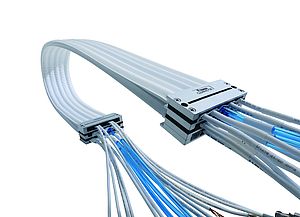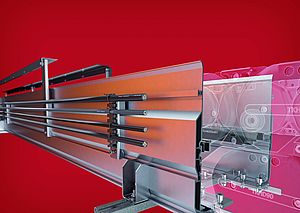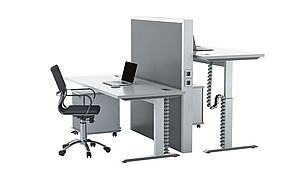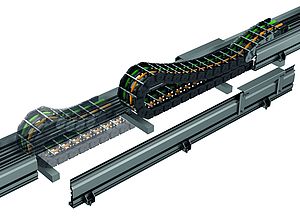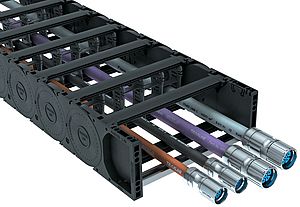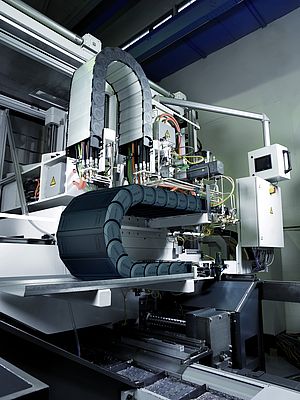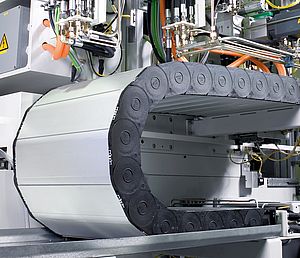When the Airbus A380 rolls out of the final assembly shop in Toulouse, the result is a gigantic aircraft that is ready to fly, but is completely bare on the inside. The interior fittings for this giant still have to be installed at the Airbus facility in Hamburg. In order to deliver the roughly 20 tonnes of necessary equipment to the required height, Airbus employs assembly platforms from Albatros Engineering, Linz, Austria, which are in turn supplied with electric, pneumatic and hydraulic energy by cable carriers from Kabelschlepp.
The medium-sized engineering firm Albatros Engineering, based in Linz, Austria, is a specialist in the development of special machines. Their planning offices create, for example, products in the field of cable winches, cable car technology and special fixtures. This also includes, for example, assembly platforms for the aviation industry.
One of Albatros Engineering's showcase projects is developing the mechanical components for assembly platforms for the Airbus A380, currently the largest civilian aircraft. Four of these systems have been delivered and put into operation so far; two more are under construction. These platforms are needed in Hamburg to install the interior fittings for the plane. The fittings, which weigh about 20 tonnes, include the seats, coverings, floorings, baggage compartments, etc. What is more, not only do the galleries have to lift the materials to the necessary height, they also have to allow access to the aircraft's total of 14 doors. Specific clearances have to be maintained in order to allow installation of the emergency slides under the doors, and the galleries also have to be adjustable to suit the different lengths of the Airbus variants.
Assembling the equipment for each aircraft requires a gallery system consisting of two levels, the upper deck and the main deck level. Transferring the gallery from the indexing position to the working position involves some 180 drives to move the 60m long, 10m wide and almost 10m high colossus, which weighs some 350 tonnes. In the indexing position the completed aircraft is pulled out and the next aircraft is brought in for installation of the fittings. This is where the people at Albatros Engineering faced their greatest technical challenges. In order for the wings to move freely under the gallery, the entire gallery system has to be lifted, allowing the supports to be removed. For this purpose lifting modules are installed under the factory roof, consisting of two heavy spindle-type lifting gear units with a common drive. It was also necessary to compensate for the bending of the factory roof. This means that the roof can bend by up to 20 centimetres.
The second challenge was the large number of flaps that dock on the aircraft's fuselage in order to keep the assembly workers from falling. On the one hand, the necessary clear space had to be retained for the various aircraft types, while on the other hand the access ways into the aircraft had to be secured.
Supplying 180 drives with power
The 180 drives, flaps and other moving parts naturally have to be supplied with various types of energy. Because the gallery system can move in the horizontal and vertical directions, its supply systems have to be just as flexible. Cable carriers promised to be a safe and cost-effective solution here. Engineer Johann Pichler, co-founder and Managing Partner at Albatros Engineering, chose cable carriers from Kabelschlepp because this manufacturer is one of the three suppliers of cable carriers approved by Airbus.
When it comes to cable carriers made of plastic for industrial applications, the company's product spectrum ranges from the economical standard solutions of the MONO and UNIFLEX Series, with fixed carrier widths, to the carriers of the K, M and MASTER Series, with variable carrier widths.
A hybrid carrier is the solution of choice
In the Airbus gallery systems developed by Albatros Engineering, the main cable carrier is a Kabelschlepp carrier of the type MC 1250 with an inner width of 600 millimetres and a length of seven metres. This type is a hybrid carrier, i.e. it consists of plastic sidebands and aluminium stays for high stability and gentle cable routing. Due to the great width of the carrier, for reasons of stability a solid frame stay, double screwed on both sides (type RM) is used here. Height separation is by means of riveted aluminium tube stays, which also contribute to the stability of the overall system.
The carrier contains the lines for the power supply and control of the 180 drives, as well as the special shielded HF cables bearing the 100 Hz power supply for the entire aircraft, and the IT cables for the aircraft. And then there are the compressed air and hydraulic lines. All in all, the carrier contains about 20 different cables and hoses.
The gallery systems are equipped with four additional cable carriers for secondary motions. Here the economical solid plastic carrier UNIFLEX with inner widths of 125 millimetres and 58 millimetres and heights of 38 and 26 millimetres satisfied the Albatros requirements. UNIFLEX types 0455 and 0555 with hinged, openable and detachable outside locking brackets on both sides are used. The carrier cross-section is separated vertically using the divider system TS 0.











